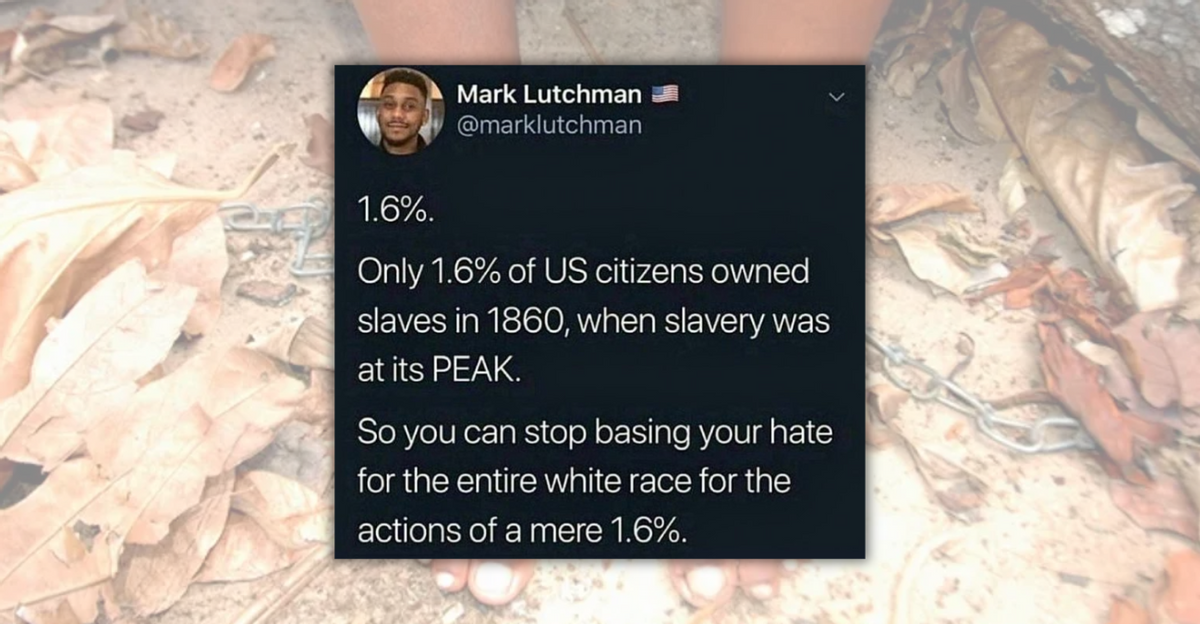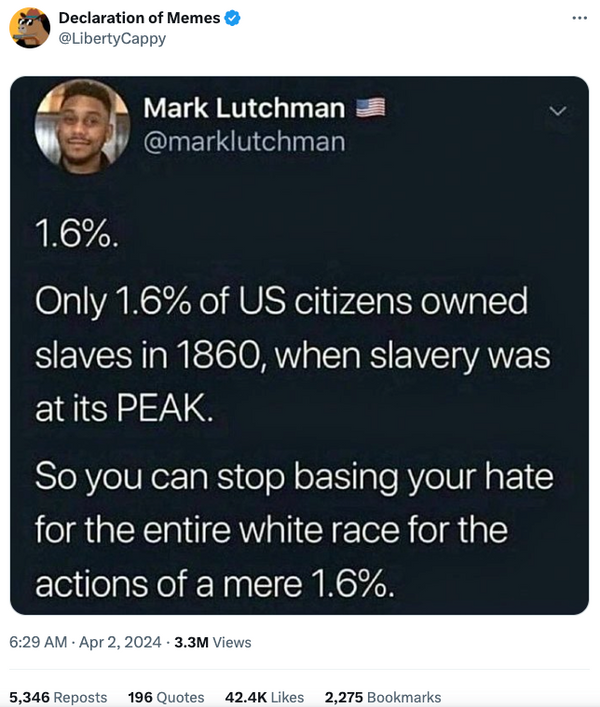It's Claimed that Only 1.6% of US Citizens Owned Slaves In 1860. We Ran the Numbers

On April 2, 2024, the claim that "only 1.6% of US citizens owned slaves in 1860" went viral on X (formerly Twitter):

Though the 3.3 million people who viewed this statement (at the time of this reporting) may not be aware, this claim is part of an long-standing genre of online memes that use a misleading statistic to minimize the importance of slavery to antebellum America.
The actual percentage reported in these memes varies, Snopes has observed, from 1.3 percent to the present 1.6 percent. As Snopes reported in August 2019, the statistic to which these memes refer is most accurately conveyed as 1.4 percent.
The earliest instance of the 1.4 percent version entering the digital lexicon with the purpose of minimizing white culpability for slavery appears to be a 2005 article on Vice titled "Hey Kids ... It's Time For Some Dumb Myths And Smart Facts About Slavery!" which opens with this premise:
If you're white like Uncle Jim, your teachers will try to convince you that you're responsible … for a bunch of bad, bad things that happened a long, long time ago. If you're a black schoolchild, I'm sure your parents will have plenty of excuses for why your ancestors were enslaved.
But chances are that you're white — at least for the next generation or two, those are the chances — so I've collected a bunch of DUMB MYTHS and SMART FACTS about slavery that you can use to clown your teachers and everyone else at school!
One of those "smart facts" was the claim phrased in much the same way the viral memes currently make use of it over a decade later:
At the peak of black slavery in the South, only 6 percent of Southern whites owned slaves. If you include the white people in the North, it means that only 1.4 percent of white Americans owned black slaves at the HEIGHT of slavery.
It is unclear how the number has shifted between 1.3 and 1.6 percent over time, but the actual number doesn't really matter. The point, these memes argue, is that the number is small, and therefore Black people should not hold animus toward White people for the crimes of their ancestors. The message stays the same, even when the numbers do not.
Where Does This Small Number Come From?
The year 1860 was a census year. Officials collected detailed information on slave ownership and distribution in the Southern states, and this data, while far from perfect, is likely the most reliable source of information for the state of slavery directly preceding the Civil War.
Among the data collected were the total population of each state — both free and enslaved — as well as family and household statistics. These data can be found in the state-level population reports for 1860 published by the U.S. Census Bureau. Another set of relevant data concerns slave ownership. A table for each slave state documenting the number of slaves and slave owners is found beginning on page 223 of the 1860 Census report "Agriculture of the United States in 1860."
The Civil War Home Page has collated this info into a single table that is often cited to help address the question of what percentage of whites owned slaves at the peak of slavery. A portion of that information is presented below:
1860 Census
Total Population
31,183,582
Total No. of Slaves
3,950,528
No. of Families
5,155,608
Total Free Population
27,233,198
Total No. of Slaveholders
393,975
Slaves as a Percent of the Population
13%
The number 1.4% is likely derived by taking the number of "slaveholders" (393,975) as a fraction of the "total free population" (27,233,198), which yields 1.4%. For several reasons enumerated below, that number grossly downplays the number of whites who were involved and who benefited directly from slavery.
(Additionally, the premise behind each of these types of calculations betrays a false assumption that non-slaveholding whites had no role in supporting or benefiting from the institution of slavery in the 1860s.)
Total Number of Slaveholders Is Not the Proper Metric
Adam Rothman, a historian at Georgetown University and an expert in the history of slavery who spoke to us via email, told us that the percentage of slaveholding families is "the better measure of the extent of slaveholding." One reason this is true, according to historian Adam Goodheart in an interview with Politifact in August 2017, is that a person could be (and often was) a "slave master" but not technically a "slave owner":
"Many non-slaveholding whites in the South rented slaves from wealthier slaveholders ... so it was very common for a white Southerner to be a 'slave master' but not technically a 'slave owner.'"
Similarly, the head of a household may have been the legal owner of a slave, but that slave would still perform work that would benefit the family, household, or business as a whole. Those non-owners, when using the metric "total number of slaveholders," would not be included as having participated in the institution of slavery. Using census numbers for the percentage of families who held slaves, the nationwide calculation for the percentage of "families owning slaves," is 7.4%, Rothman told us.
Nevertheless, this result, while still several times greater than the numbers presented in the memes, is still misleading.
Including Free States Dilutes the Percentages
By 1860, 20 out of the United States' 35 states had outlawed slavery. Each of those 20 states recorded 0% of slave-owning families in the 1860 census. Memes such as the one under discussion, which include the states where slavery had already been outlawed, dilute the significance of slavery in those remaining states where individuals were not legally banned from the practice. In those states, the number ranged from 3 percent to just shy of 50%:
1860 Census
Families Owning Slaves (%)
Delaware
3
Maryland
12
Missouri
13
Arkansas
20
Kentucky
23
Tennessee
25
Virginia
26
North Carolina
28
Texas
28
Louisiana
29
Florida
34
Alabama
35
Georgia
37
South Carolina
46
Mississippi
49
All but five of those states contained at least 25% of the families as slaveholders — some nearly double that. As pointed out by Jamelle Bouie and Rebecca Onion in a 2015 Slate article, these numbers are "roughly the same percentage of Americans who, today, hold a college degree." This number is far from insignificant, even working from the flawed assumption that only people who directly owned slaves were responsible for the institution's survival into the 1860s.
A 'Slave Society' Is Larger Than Slave Ownership
Historians of American slavery often distinguish between a "society with slaves" (which is historically common) and a "slave society" in which slavery formed the basis of a political and economic system (which is historically rare). Explaining this distinction for a 2012 Atlantic article, Ta-Nehisi Coates argued:
The basic point is that you can't think of slavery in the antebellum South as simply something people did. Slavery defined people — slaves, slave-owners, non-slave holding whites, free blacks and native Americans. Politically, the slave society impacted everything from Henry Clay's push for the American System to the Nullification Crisis to the Mexican War.
In 1860, 90% of America's black population was enslaved, and blacks made up over 50% of the population of states like South Carolina and Mississippi. To suggest this ubiquity of human bondage in 1860s America was the result of only 1.4% "1.6% of whites" owning slaves would be, to put it mildly, an inaccurate reading of U.S. history.
Sources:
Goad, Jim. "Hey Kids ... It's Time For Some Dumb Myths And Smart Facts About Slavery!" Vice News. 1 December 2005.
United States Census Bureau. "1860 Census: Population of the United States" 1864.
United States Census Bureau. "Agriculture of the United States in 1860." 1864.
The Civil War Home Page. " Results from the 1860 Census." Accessed 7 August 2019.
Strausbaugh, John. City of Sedition: The History of New York City during the Civil War. Grand Central Publishing, 2016. 1455584193.
Jacobson, Louis. "Viral Post Gets it Wrong About Extent of Slavery in 1860." Politifact. 24 August 2017.
Pérez-Peña, Richard. "U.S. Bachelor Degree Rate Passes Milestone." The New York Times. 23 February 2012.
Berlin, Ira. Many Thousands Gone: The First Two Centuries of Slavery in North America. Belknap Press, 1999. 9780674002111
Coates, Ta-Nehisi. "The Slave Society Defined." The Atlantic. 6 September 2011.
Gates, Jr., Henry Louis. "Slavery, by the Numbers." The Root. 10 February 2014.

